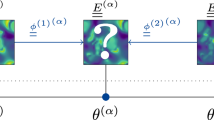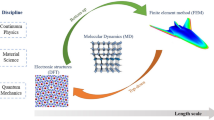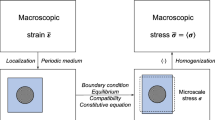Abstract
Image-based simulation is becoming an appealing technique to homogenize properties of real microstructures of heterogeneous materials. However fast computation techniques are needed to take decisions in a limited time-scale. Techniques based on standard computational homogenization are seriously compromised by the real-time constraint. The combination of model reduction techniques and high performance computing contribute to alleviate such a constraint but the amount of computation remains excessive in many cases. In this paper we consider an alternative route that makes use of techniques traditionally considered for machine learning purposes in order to extract the manifold in which data and fields can be interpolated accurately and in real-time and with minimum amount of online computation. Locallly Linear Embedding is considered in this work for the real-time thermal homogenization of heterogeneous microstructures.








Similar content being viewed by others
References
Aguado JV, Huerta A, Chinesta F, Cueto E (2015) Real-time monitoring of thermal processes by reduced order modelling. Int J Numer Methods Eng 102(5):991–1017
Ammar A, Mokdad B, Chinesta F, Keunings R (2006) A new family of solvers for some classes of multidimensional partial differential equations encountered in kinetic theory modeling of complex fluids. J Non-Newton Fluid Mech 139:153–176
Ammar A, Mokdad B, Chinesta F, Keunings R (2007) A new family of solvers for some classes of multidimensional partial differential equations encountered in kinetic theory modeling of complex fluids. Part II: Transient simulation using space-time separated representation. J Non-Newton Fluid Mech 144:98–121
Amsallem D, Farhat C (2008) Interpolation method for adapting reduced-order models and application to aeroelasticity. AIAA J 46:1803–1813
Amsallem D, Cortial J, Farhat C (2010) Toward real-time CFD-based aeroelastic computations using a database of reduced-order information. AIAA J 48:2029–2037
Bialecki RA, Kassab AJ, Fic A (2005) Proper orthogonal decomposition and modal analysis for acceleration of transient FEM thermal analysis. Int J Numer Methods Eng 62:774–797
Bui-Thanh T, Willcox K, Ghattas O, Van Bloemen Waanders B (2007) Goal-oriented, model-constrained optimization for reduction of large-scale systems. J Comput Phys 224(2):880–896
Calo VM, Efendiev Y, Galvisd J, Ghommem M (2014) Multiscale empirical interpolation for solving nonlinear PDEs. J Comput Phys 278:204–220
Chinesta F, Ammar A, Lemarchand F, Beauchene P, Boust F (2008) Alleviating mesh constraints: model reduction, parallel time integration and high resolution homogenization. Comput Methods Appl Mech Eng 197(5):400–413
Chinesta F, Ladeveze P, Cueto E (2011) A short review in model order reduction based on proper generalized decomposition. Arch Comput Methods Eng 18:395–404
Chinesta F, Leygue A, Bordeu F, Aguado JV, Cueto E, Gonzalez D, Alfaro I, Ammar A, Huerta A (2013) Parametric PGD based computational vademecum for efficient design, optimization and control. Arch Comput Methods Eng 20(1):31–59
Chinesta F, Keunings R, Leygue A (2014) The proper generalized decomposition for advanced numerical simulations: a primer. Springer, New York
Cremonesi M, Neron D, Guidault PA, Ladeveze P (2013) PGD-based homogenization technique for the resolution of nonlinear multiscale problems. Comput Methods Appl Mech Eng 267:275–292
Geers MGD, Kouznetsova VG, Brekelmans WAM (2009) Multi-scale computational homogenization: trends and challenges. J Comput Appl Math. doi:10.1016/j.cam.2009.08.077
Ghnatios Ch, Masson F, Huerta A, Cueto E, Leygue A, Chinesta F (2012) Proper generalized decomposition based dynamic data-driven control of thermal processes. Comput Methods Appl Mech Eng 213:29–41
Girault M, Videcoq E, Petit D (2010) Estimation of time-varying heat sources through inversion of a low order model built with the modal identification method from in-situ temperature measurements. Int J Heat Mass Transf 53:206–219
Gonzalez D, Cueto E, Chinesta F (In press) Computational patient avatars for surgery planning. Ann Biomed Eng
Halabi FE, González D, Chico A, Doblaré M (2013) FE\(^2\) multiscale in linear elasticity based on parametrized microscale models using proper generalized decomposition. Comput Methods Appl Mech Eng 257:183–202
Jiang M, Jasiuk I, Ostoja-Starzewski M (2002) Apparent thermal conductivity of periodic two-dimensional composites. Comput Mater Sci 25(3):329–338
Kanit T, Forest S, Galliet I, Mounoury V, Jeulin D (2003) Determination of the size of the representative volume element for random composites: statistical and numerical approach. Int J Solids Struct 40(13–14):3647–3679
Kanit T, N’Guyen F, Forest S, Jeulin D, Reed M, Singleton S (2006) Apparent and effective physical properties of heterogeneous materials: representativity of samples of two materials from food industry. Comput Methods Appl Mech Eng 195(33–36):3960–3982
Ladevèze P (1989) The large time increment method for the analyze of structures with nonlinear constitutive relation described by internal variables. C R Acad Sci Paris 309:1095–1099
Ladevèze P, Nouy A (2003) On a multiscale computational strategy with time and space homogenization for structural mechanics. Comput Methods Appl Mech Eng 192(28–30):3061–3087
Ladevèze P, Néron D, Gosselet P (2007) On a mixed and multiscale domain decomposition method. Comput Methods Appl Mech Eng 96:1526–1540
Ladevèze P, Passieux J-C, Néron D (2010) The latin multiscale computational method and the proper generalized decomposition. Comput Methods Appl Mech Eng 199(21–22):1287–1296
Lamari H, Ammar A, Cartraud P, Legrain G, Jacquemin F, Chinesta F (2010) Routes for efficient computational homogenization of non-linear materials using the proper generalized decomposition. Arch Comput Methods Eng 17(4):373–391
Lopez E, Abisset-Chavanne E, Lebel F, Upadhyay R, Comas-Cardona S, Binetruy C, Chinesta F (In press) Advanced thermal simulation of processes involving materials exhibiting fine-scale microstructures. Int J Mater Form. doi:10.1007/s12289-015-1222-2
Maday Y, Ronquist EM (2002) A reduced-basis element method. C R Acad Sci Paris Ser I 335:195–200
Maday Y, Patera AT, Turinici G (2002) A priori convergence theory for reduced-basis approximations of single-parametric elliptic partial differential equations. J Sci Comput 17(1–4):437–446
Maday Y, Ronquist EM (2004) The reduced basis element method: application to a thermal fin problem. SIAM J Sci Comput 26(1):240–258
Ostoja-Starzewski M (2006) Material spatial randomness: from statistical to representative volume element. Probab Eng Mech 21(2):112–132
Park HM, Cho DH (1996) The use of the Karhunen–Loève decomposition for the modelling of distributed parameter systems. Chem Eng Sci 51:81–98
Polito M, Perona P (2001) Grouping and dimensionality reduction by locally linear embedding. In: Advances in neural information processing systems 14. MIT Press, Cambridge, pp 1255–1262
Roweis ST, Saul LK (2000) Nonlinear dimensionality reduction by locally linear embedding. Science 290:2323–2326
Rozza G, Huynh DBP, Patera AT (2008) Reduced basis approximation and a posteriori error estimation for affinely parametrized elliptic coercive partial differential equations: application to transport and continuum mechanics. Arch Comput Methods Eng 15(3):229–275
Ryckelynck D, Hermanns L, Chinesta F, Alarcon E (2005) An efficient a priori model reduction for boundary element models. Eng Anal Bound Elem 29:796–801
Ryckelynck D (2005) A priori hypereduction method: an adaptive approach. J Comput Phys 202:346–366
Ryckelynck D, Chinesta F, Cueto E, Ammar A (2006) On the a priori model reduction: overview and recent developments. Arch Comput Methods Eng State Art Rev 13(1):91–128
Sab K (1992) On the homogenization and the simulation of random materials. Eur J Mech A Solids 11(5):585–607
Scholkopf B, Smola A, Muller KR (1998) Nonlinear component analysis as a kernel eigenvalue problem. Neural Comput 10(5):1299–1319
Scholkopf B, Smola A, Muller KR (1999) Kernel principal component analysis. In: Advances in kernel methods: support vector learning. MIT Press, Cambridge, pp 327–352
Tenenbaum JB, de Silva V, Langford JC (2000) A global framework for nonlinear dimensionality reduction. Science 290:2319–2323
Videcoq E, Quemener O, Lazard M, Neveu A (2008) Heat source identification and on-line temperature control by a branch eigenmodes reduced model. Int J Heat Mass Transf 51:4743–4752
Wang Q Kernel principal component analysis and its applications in face recognition and active shape models. arXiv:1207.3538
Yvonnet J, Gonzalez D, He Q-C (2009) Numerically explicit potentials for the homogenization of nonlinear elastic heterogeneous materials. Comput Methods Appl Mech Eng 198(33–36):2723–2737
Zimmer VA, Lekadir K, Hoogendoorn C, Frangi AF, Piella G (2015) A framework for optimal kernel-based manifold embedding of medical image data. Comput Med Imaging Graph 41:93–107
Author information
Authors and Affiliations
Corresponding author
Additional information
This work has been partially supported by the Spanish Ministry of Science and Competitiveness, through Grants Number CICYT-DPI2014-51844-C2-1-R. Professor Chinesta is also supported by the Institut Universitaire de France.
Appendix: On Computational Homogenization
Appendix: On Computational Homogenization
In this section the simplest procedure related to computational homogenization is revisited. Due to the microscopic heterogeneity, the macroscopic thermal modeling needs a homogenized thermal conductivity which depends on the microscopic details. To compute this homogenized thermal conductivity an appropriate RVE is considered at position \({\mathbf {X}} \in \varOmega\), \(\omega ({\mathbf {X}})\) [20, 21, 31] in which the microstructure is perfectly defined at this scale.
In the linear case the local microscopic conductivity \({\mathbf {k}}({\mathbf {x}})\) is known at each point \({\mathbf {x}}\) in the microscopic domain \(\omega ({\mathbf {X}})\).
We can define the macroscopic temperature gradient at position \({\mathbf {X}}\), \({\mathbf {G}} ({\mathbf {X}})\), from:
where the temperature gradient writes \({\mathbf {g}} ({\mathbf {x}}) = \nabla T({\mathbf {x}})\).
We also assume the existence of a localization tensor \({\mathbf {L}}({\mathbf {x}}, {\mathbf {X}})\) such that
The microscopic heat flux \({\mathbf {q}}\) writes according to Fourier’s law
and its macroscopic counterpart \({\mathbf {Q}}({\mathbf {X}})\) reads:
from which the homogenized thermal conductivity can be defined from
Since \({\mathbf {k}}({\mathbf {x}})\) is perfectly known everywhere in the representative volume element \(\omega ({\mathbf {X}})\), the definition of the homogenized thermal conductivity tensor only requires the computation of the localization tensor \({\mathbf {L}}({\mathbf {x}}, {\mathbf {X}})\). Several approaches are proposed in the literature to define this tensor, according to the choice of boundary conditions. The objective here is not to discuss this choice. The interested reader can find some details in [14, 19, 20, 39]. For the sake of simplicity, we use essential boundary conditions on \(\partial \omega ({\mathbf {X}})\) corresponding to the assumption of uniform temperature gradient on the RVE \(\omega ({\mathbf {X}})\). We consider the general 3D case that involves the solution of the three boundary-value problems related to the steady state heat transfer model in the microscopic domain \(\omega ({\mathbf {X}})\) for three different boundary conditions on \(\partial \omega ({\mathbf {X}})\):
and
It is easy to prove that these three solutions verify
where \((\cdot )^T\) denotes the transpose. Thus, the localization tensor results finally:
The resulting non-concurrent homogenization procedure is illustrated in Fig. 9. As soon as tensor \({\mathbf {L}} ({\mathbf {x}}, {\mathbf {X}})\) is known at each position \({\mathbf {x}}\), the constitutive law relating the macroscopic temperature gradient and the macroscopic heat flux becomes fully defined.
Rights and permissions
About this article
Cite this article
Lopez, E., Gonzalez, D., Aguado, J.V. et al. A Manifold Learning Approach for Integrated Computational Materials Engineering. Arch Computat Methods Eng 25, 59–68 (2018). https://doi.org/10.1007/s11831-016-9172-5
Received:
Accepted:
Published:
Issue Date:
DOI: https://doi.org/10.1007/s11831-016-9172-5





